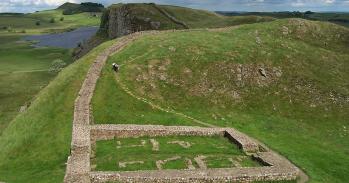
The latest instalment of a 20-year study to understand how Britain became an island completes a tale of megafloods and super-rivers.
The latest instalment of a 20-year study to understand how Britain became an island completes a tale of megafloods and super-rivers.
With this new research, there is now a complete record that reconstructs these dramatic and far-reaching events that were to give Britain its island status.
Deep below the Bay of Biscay, where the English Channel meets the Atlantic Ocean, layers of sediment hold precious information about how Britain came to be separated from mainland Europe. Until recently, the clues had remained hidden, off limits owing to the impracticalities and cost of obtaining long-piston core samples and high-resolution acoustic data in this area. However, thanks to an Anglo-French collaboration between Professor Phil Gibbard, who leads the Quaternary Palaeoenvironments Group in the Department of Geography, and PhD student Sam Toucanne and his colleagues from the University of Bordeaux and the French Research Institute for Exploitation of the Sea (IFREMER), the seabed has now yielded its secrets. In doing so, it provides the final instalment in a story that has been unfolding for two decades, since Professor Gibbard first began his detailed palaeogeographic and paleoenvironmental reconstructions of the southern North Sea.
When Britain actually was in Europe
But the story really starts 500,000 years ago, five ice ages before present times, when Britain was connected to Europe through a land mass that stretched from The Netherlands to the Dover Strait. Between Britain and France was a wide shallow area into which southerly rivers like the Somme and the Seine drained, while the Thames and the Rhine drained northwards into the North Sea.
Indications as to what happened to the landmass over the ensuing half a million years have been found in sedimentary investigations of the geological history of the southern North Sea region and neighbouring areas by Professor Gibbard. These provided a read-out of past environments, including climatic changes, and of how and where the rivers flowed during the past. Together with bathymetric maps (sonar readings of the floor of the English Channel, showing the topography of deep valleys running the length of the waterway), it has been possible to build up a detailed picture of the conditions of the region: where rivers drained, glaciers formed and landmasses changed.
Most recently, the scientists have been able to build up a continuous record of the Earth’s climate variability for the past 1,200,000 years, showing a correspondence between temperature changes caused by the waxing and waning of the glaciers and the peaks and lows in sedimentary deposits. The data show that three of the five ice ages – 450,000 years, 160,000 years and 30,000 years ago – seem to have had the most dramatic impacts on the sedimentary deposits. Could one or more of these ice ages have precipitated the events that resulted in Britain becoming separated from Europe?
Megafloods and super-rivers
The first breakthrough came when Professor Gibbard’s investigations of the southern North Sea region and review of the drainage systems led him to suggest the existence some 450,000 years ago of a massive lake. The meeting of a glacier flowing down across Britain from the north and a glacier advancing from Denmark strongly modified the flow directions of central European rivers, effectively blocking their flow into the Atlantic Ocean. The result was the build-up of a large, freshwater, glacial lake, about the size of East Anglia, just north of what is now the Dover Strait. The lake was dammed by an ice sheet, landmass and, crucially, the upfolded spit of land that linked Britain and France at the Dover Strait.
The first morphological evidence came to light in 2007 from the bathymetric maps of the English Channel. Dr Sanjeev Gupta at Imperial College London observed that the existence of long grooves of erosion and deep valleys running longitudinally along the bedrock floor fitted with an extraordinary conclusion. It seems that the freshwater lake filled until, like an overflowing bath, it breached the Dover Strait. A catastrophic discharge of water surged at least once and probably twice down the basin between Britain and France, overwhelming the rivers and streams below it, and spreading out across the basin as a megaflood. This massive southwards discharge of meltwaters merged with the river-water from the Seine, Somme and others, to form the ‘Fleuve Manche’ (Channel River) palaeoriver, one of the largest river systems on the European continent.
Further ice ages followed. Each time, as the glaciers receded, sea levels rose and the Channel would continue to be carved out; as glaciers returned, sea levels dropped and the landmass would once more connect Britain to the Continent. A second megaflood seems to have happened 160,000 years ago, only this time the gap at the Dover Strait was enlarged enough that it would never reform: Britain was now an island.
A full reconstruction
The recently published Anglo-French study has provided the final piece of the puzzle by looking, for the first time, at what flowed out of the Channel into the Bay of Biscay during these crucial periods of Quaternary history. Corroborating the story that had emerged from the upstream sedimentary analyses and the bathymetric data, this new research demonstrates peaks and troughs in character and volume of the sedimentary material relating to the interglacial and glacial periods. Significantly, at the times identified for the megaflood, the scientists found that the volume and character of the sedimentary material vastly increased, consistent with massive surges in ice-rafted debris and sediment having swept down the Fleuve Manche super-river and out into the Bay of Biscay. With this new research, there is now a complete record that reconstructs these dramatic and far-reaching events that were to give Britain its island status.
Like any other large-scale geographical upheaval, the implications of the megaflood are profound. The large volume of freshwater released into the Atlantic would have caused changes in ocean circulation, with knock-on effects on the climate in an area stretching from the Bay of Biscay to North Africa. Flora and fauna (including early humans) would also have been affected: during interglacial periods such as the one we are currently experiencing, the high sea level would cut Britain off from mainland Europe, forming a barrier to the migration of humans, animals and plants alike. But in glacial periods, the water level would fall and, although there would never again be a continuous landmass linking Britain with Europe, the Channel River would provide a major migration routeway. In fact it was probably possible to wade across from France to Britain as few as 9,000 years ago, and this may yet be possible tens of thousands of years from now, when we enter the next ice age.
For more information, please contact Professor Phil Gibbard (plg1@cam.ac.uk) at the Quaternary Palaeoenvironments Group (www.qpg.geog.cam.ac.uk/) in the Department of Geography or Sam Toucanne (Samuel.Toucanne@ifremer.fr). This research was published in Quaternary Science Reviews (2009) 28, 1238–1256 and Nature(2007) 448, 259–260.
This work is licensed under a Creative Commons Licence. If you use this content on your site please link back to this page.





